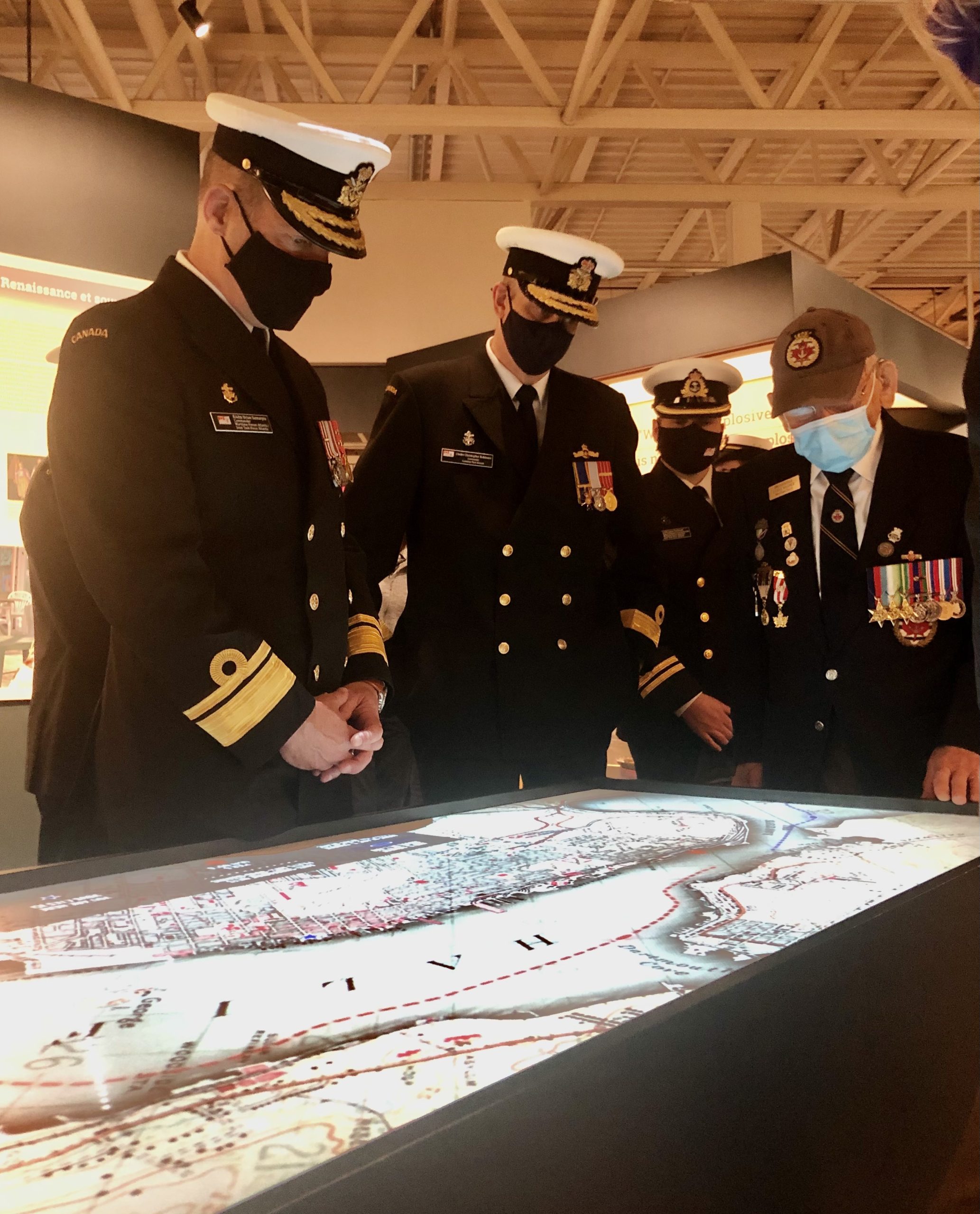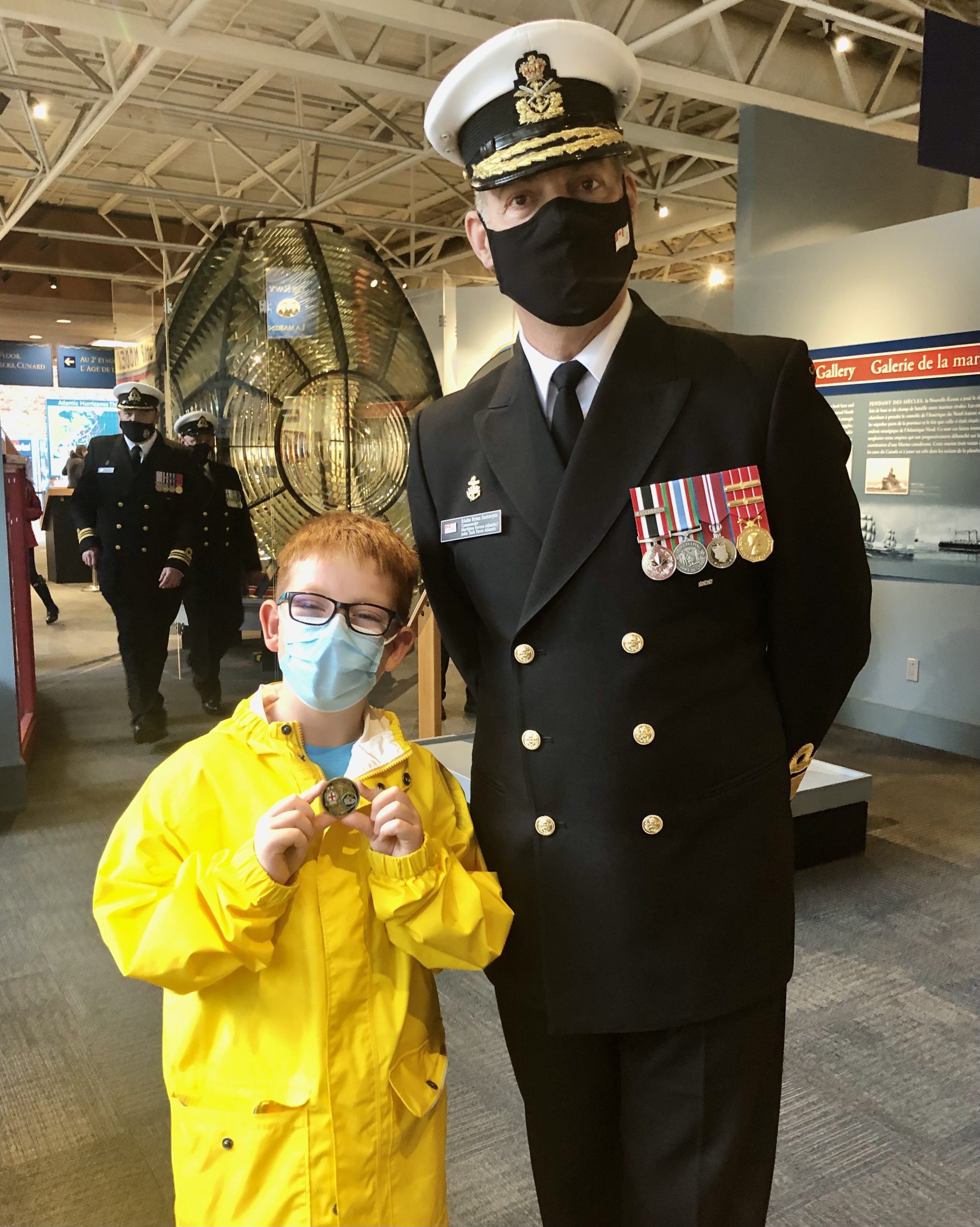
JONIE VEITCH, TRIDENT STAFF
79th anniversary of the sinking of SS Caribou
By Joanie Veitch,
Trident Staff
Barely tall enough to see over the second-level railing at the Maritime Museum of the Atlantic, eight-year-old Daniel Drover stood riveted to the scene unfolding in the lower-level gallery below, as naval officers and veterans gathered on October 14 to commemorate the 79th anniversary of the sinking of SS Caribou.

JOANIE VEITCH, TRIDENT STAFF
After standing ramrod straight through the playing of the Last Post and two minutes of silence that followed, the young boy was up on tiptoes to watch as Rear-Admiral Brian Santarpia, Commander Maritime Forces Atlantic, and Captain (Ret’d) Earle Wagner, Merchant Navy veteran, laid a wreath at the Merchant Navy Memorial.
Held each year in remembrance of the 136 people who perished in the sinking of the Newfoundland ferry SS Caribou on October 14, 1942, the ceremony also pays tribute to thousands of Canadians who volunteered their service during the Second World War.
Approximately 12,000 men and women served in Canada’s Merchant Navy during the war.
According to Royal Canadian Navy information on the Battle of the Atlantic, 59 Canadian-registered merchant ships were sunk by enemy or probable enemy action, and 2,000 RCN members, 1,600 Canadian merchant seamen and 752 Canadian airmen lost their lives.
Opening his talk with a reading from The Sea Is at Our Gates, a book about the Battle of the Atlantic, written by Tony German, RAdm Santarpia spoke of the constant danger faced by the Merchant Navy as they “fought and won” the longest battle of the Second World War.
“It’s fitting that we chose today, as a nation, to commemorate the efforts of the Merchant Marine – the 14th of October – because on that day in 1942, SS Caribou was sunk… marking the greatest loss of life in the Battle of the Atlantic in Canadian waters,” he said.
SS Caribou was a steamship ferry that operated between Nova Scotia and Newfoundland. On the evening of October 13, 1942, the vessel left Sydney, NS with 237 people on board: 46 crew members, 118 military personnel and 73 civilians, including 11 children. Escorting Caribou as she crossed the Cabot Strait was HMCS Grandmère, a minesweeper.
Travelling overnight, the ferry was torpedoed and sunk in the early morning hours by a German submarine less than 40 kilometres southwest of Port aux Basques. Of the 237 people on board, 137 died — 57 military personnel, 49 civilians and 31 crew members.
One of the survivors, Nursing Sister LCdr Margaret Brooke, received a Member of the Order of the British Empire for her efforts to save her friend, Nursing Sister SLt Agnes Wilkie, who died following the sinking. LCdr Brooke was the first Canadian woman to receive the award.
The RCN’s second Arctic Offshore Patrol Ship, HMCS Margaret Brooke, is being named in her honour.
LCdr Nicole Robichaud, Commanding officer of HMCS Margaret Brooke, read the Commitment to Remember at the commemoration event, following Capt (Ret’d) Wagner’s reading of the Act of Remembrance.
After the ceremony, military personnel, veterans and other visitors gathered for an informal talk and tour — led by museum staff — of the naval heritage exhibits on the museum’s ground floor.
“It is an honour to be here… to continue to share the story of LCdr Margaret Brooke and hear stories from Capt Wagner,” said LCdr Robichaud.
Capt (Ret’d) Wagner served with the Merchant Navy during the Second World War. An active member of the Canadian Merchant Navy Association, he has worked determinedly on behalf of Merchant Navy veterans.
Joining the museum tour, Daniel Drover and his dad Steven said they got a lot more from their visit to the Maritime Museum of the Atlantic than they had expected when they set off that morning.
“It was really cool to meet everyone and to see all this,” Daniel said.






